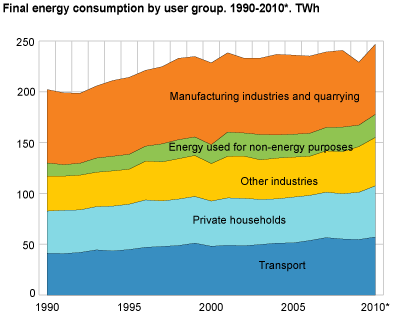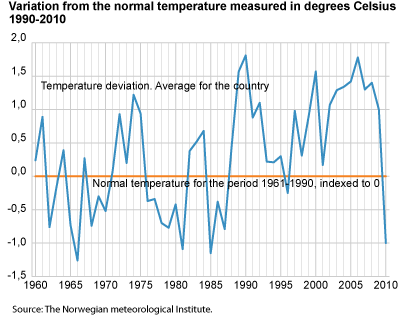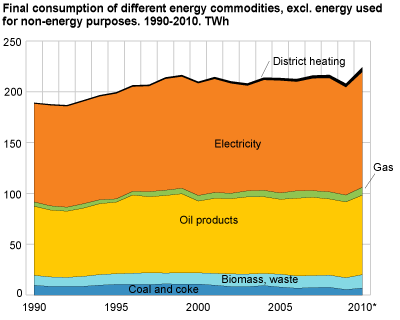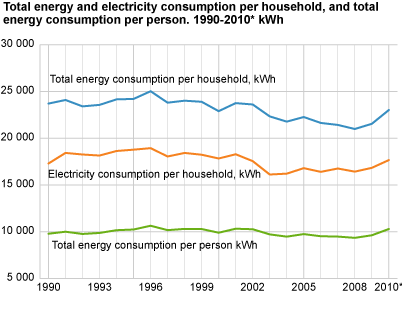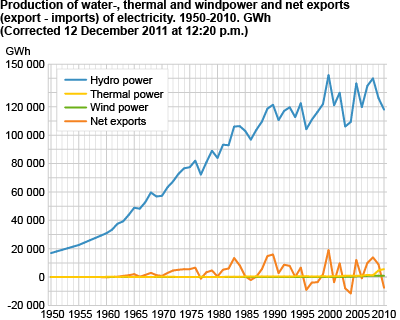Content
Published:
This is an archived release.
Record high energy consumption in 2010
Our total energy consumption in 2010 rose by 8 per cent from the previous year, and is the highest consumption ever. This is due to cold weather and economic growth.
Our total consumption of energy in 2010 made up 247 terawatt hours (TWh). This was broken down into manufacturing industries, transport and households, with 69, 57 and 50 TWh respectively. In addition, 23 TWh of energy was used for non-energy purposes. The remaining 48 TWh was used in services, primary industries, and construction.
Compared to figures from the previous energy balance published in spring 2011, the calculated energy consumption has increased somewhat. This is due to more precise information about the consumption in manufacturing industries, and consumption of district heating and fuel wood in 2010.
The large increase in energy consumption from 2009 to 2010 must be seen in relation to the fact that the total energy consumption in 2009 was low due to the financial crisis. In addition, it was warmer in 2009 than in 2010. The overall temperature for the country was one degree above normal in 2009, but one degree below normal in 2010. 2010 is the coldest year we have had since 1985. Incidentally, it has been warmer than normal almost every year since 1988, compared to the climatic normal which is based on temperatures for the period 1961-1990.
Half of our energy consumption is electricity
Consumption of electricity and oil products, which is mainly used in transport, made up 51 and 35 per cent respectively of our total energy consumption in 2010. Energy used for non-energy purposes and consumption in oil and gas extraction and other energy producing industries is not included in these figures. Electricity and oil products rose by 7 and 5 per cent respectively compared with 2009. The remaining energy consumption consists of coal, coke, biomass, gas and district heating, and this had an even higher growth from the previous year.
Higher energy consumption in households and services.
Energy consumption in households (except in private cars) rose by 8 per cent from the previous year, and came to a record high 50 TWh. This is due to the cold winter months in 2010. Consumption of electricity, district heating, oil products and fuel wood all increased. Consumption of electricity, which makes up 77 per cent of households’ total energy consumption, rose by 6 per cent from the previous year. This was in spite of record high electricity prices of NOK 1 per kilowatt hours (kWh) in 2010. Around a fifth of households have installed a heat pump, and consequently the price for electricity for heating becomes in reality lower since one kWh of electricity used in the heat pump gives more than 1 kWh of useful energy. Consumption of district heating in households rose considerably from 2009 to 2010, by 44 per cent. This is partly due to record high investments in district heating the last couple of years. Nevertheless, district heating makes up only 2 per cent of households’ total energy consumption.
While energy consumption per household has been declining since 1996, this consumption rose by 7 per cent from 2009 to 2010, and came to 23 000 kWh per household. The decrease we have seen in energy consumption per household before 2010 is partly related to the fact that the number of persons per household has decreased. Energy consumption per person has been more stable. It has, however, also declined somewhat in recent decades, but rose in 2010, exceeding the level in 1990.
Also in services, the energy consumption rose by about 8 per cent from 2009 to 2010. This is due to cold weather, but also economic growth. While the growth in GDP for the first time in many years was negative in 2009, it rose by 0.7 per cent in 2010. Economic growth was highest in mainland Norway, at 1.9 per cent.
Growth in manufacturing industries
In manufacturing industries, most of the energy is used for industry processes. It is therefore the production level that is most important, while temperature is less significant. The energy consumption in manufacturing industries in 2010 rose by about 11 per cent from the previous year. The large increase in 2010 is related to the drop in energy consumption in manufacturing industries in 2009 as a result of the financial crisis in this year. Norwegian industries produce large amounts for export. The drop in 2009 was related to lower international demand and thereby lower exports, so the production had to be reduced. The consumption in manufacturing industries in 2009 was still at a low level compared to previously. For more details, go to industrial energy use . There are some differences in the figures for energy consumption in manufacturing industries in the energy balance and the separate publishing of this due to somewhat different definitions of industry consumption in these statistics.
Constantly more energy consumption in transport
An increasing share of our total energy consumption has been used for transport purposes in recent decades. This consumption increased by almost 40 per cent from 1990 to 2010. In 2010, the consumption rose by about 5 per cent from the previous year. Road transport is the most dominating type of transport and makes up three quarters of the total energy consumption in transport. Consumption in lorries and trucks makes up a large part of this. This could be due to the fact that Norway has a scattered settlement and industry pattern, and it is not everyone who has access to public transport, trains etc. Sales of diesel cars have increased considerably in recent years, at the sacrifice of gasoline cars. The consumption reflects this trend. While the use of gasoline declines, consumption of diesel increases. This was also the case in 2010. The gasoline consumption fell by 5 per cent from 2009 to 2010, while consumption of diesel rose by about 10 per cent.
More use of biofuels
The sale of biodiesel rose by 18 per cent from 2009 while the sale of bioethanol was seven times higher than in 2009. For more details, go to sale of petroleum products . In total, biofuels made up 3.6 per cent of the total consumption of gasoline and diesel used for road transport in 2010. Norway has recently adopted an EU directive where the target for the renewable energy share in transport consumption is 10 per cent by 2020. Increased consumption of electricity and biofuels will be important in order to achieve this. Most of the energy used in transport is however fossil fuels, and use of electricity made up only 1.2 per cent of the total transport energy consumption in 2010.
Lower electricity production
Norway’s electricity production was 124 TWh in 2010, which is 6 per cent less than in 2009, About 95 per cent of the production is based on hydro power, and the reduction is due to lower rainfall and less water inflow to the water basins. Thermal power (which is electricity produced by gas, biomass, landfill gas etc.) has more than tripled since 2008, and made up 4.5 per cent of our total electricity production in 2010. This is due to the commissioning of several gas power plants. About 90 per cent of the thermal power is produced by fossil fuels, hence mostly natural gas.
|
This publication comprises both energy balance and energy account tables. These are based on more or less the same figures, but are presented according to different principles and definitions, where the energy accounts follow the definitions in the national accounts and the energy balance comprises the energy consumption on Norwegian territory. These tables therefore give different figures for energy consumption. For more details, see About the statistics . This text presents results from the energy balance. |
Tables:
- Table 1 Energy sources balance sheet for Norway. 2010. Preliminary figures.
- Table 2 Energy balance sheet for Norway. 2010. Petajoule.
- Table 3 Energy balance sheet for Norway. 2010. GWh. Preliminary figures.
- Table 4 Energy accounts. Extraction, conversion and use of energy goods. 2010. Preliminary figures
- Table 5 Energy accounts. Use of energy goods outside the energy sectors, by industry. 2010. Preliminary figures
- Table 6 Energy accounts. Extraction, conversion and use of energy goods. 2010. Preliminary figures. PJ
- Table 7 Energy accounts. Extraction, conversion and use of energy goods. 2010. Preliminary figures. GWh
- Table 8 Energy sources balance sheet for Norway. 2009.
- Table 9 Energy balance sheet for Norway. 2009. Petajoule.
- Table 10 Energy balance sheet for Norway. 2009. GWh
- Table 11 Energy accounts. Extraction, conversion and use of energy goods. 2009
- Table 12 Energy accounts. Use of energy goods outside the energy sectors, by industry. 2009
- Table 13 Energy accounts. Extraction, conversion and use of energy goods. 2009. PJ
- Table 14 Energy accounts. Extraction, conversion and use of energy goods. 2009. GWh
- Table 15 Energy use in Norway 1998-2010, exclusive international maritime transport and commodities used as raw materials. Renewable and non-renewable energy. TWh and per cent
- Table 16 Net consumption of individual energy products. 1976-2010*
- Table 17 Energybalance 1998- 2010*. Petajoule
- Table 18 Percentage share of energy consumption, by individual energy commodities. 1998-2010*
- Table 19 Energy consumption in households, incl. holiday cottages. 1990-2010*
- Table 20 Energy consumption in households and holiday cottages. 1990-2010*. GWh.
- Table 21 Average electricity prices and prices of selected petroleum products. Excluding and including taxes. 1993-2010
- Table 22 Calculated prices of utilized energy. 1978-2010. Fixed 1998-prices. øre/kWh. All taxes included
- Table 23 Energy balance, total energy 1998-2010. GWh
- Table 24 Supply and use of electricity 1998-2010. GWh
The statistics is now published as Production and consumption of energy, energy balance and energy account.
Additional information
The statistics are published in spring and autumn. The spring publication is preliminary and aggregated to a larger degree, and only includes figures for energy balance. In the autumn publication, tables are also presented for the energy accounts.
Contact
-
Statistics Norway's Information Centre
E-mail: informasjon@ssb.no
tel.: (+47) 21 09 46 42

